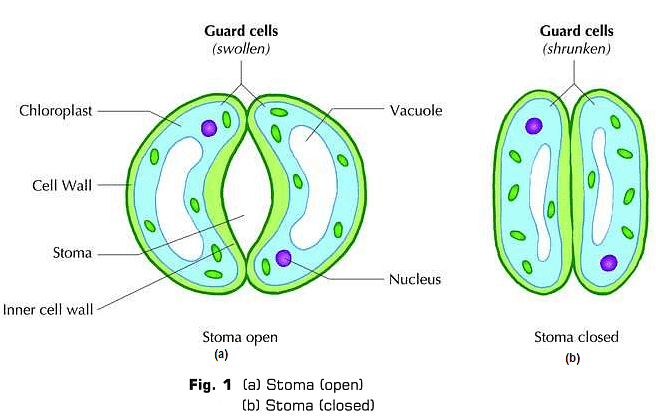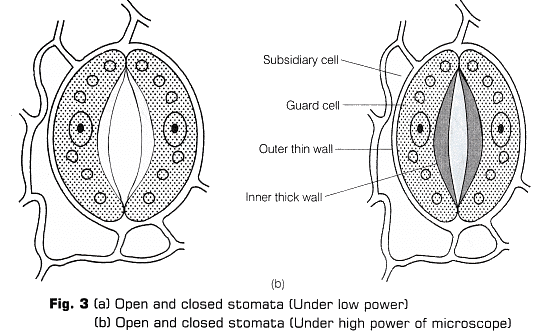Lab Manual: Stomata | Lab Manuals for Class 10 PDF Download
Objective
To prepare a temporary mount of a leaf peel to show its stomata.Materials Required
Fresh leaves from a dicot (either Petunia, Dianthus or Solanum) and a monocot (either lily, maize or grass) plants, needle, forceps, brush, glycerine, watch glass, slide, cover slips, safranin solution, blotting paper, distilled water and a compound microscope.
Theory/Principle
The leaves in a plant are its flat, green part originating from the nodes of stems on its branches.- In plants, physiological processes such as respiration and photosynthesis involve exchange of gases between plant tissues and the external atmosphere. This occurs through minute microscopic pores called stomata (singular, stoma) present in the leaf.
- The stomata is an elliptical pore which are found on the surface of leaves, i.e. both the upper and lower epidermis. These minute pores possess chloroplasts and are enclosed by two-kidney shaped guard cells on its either side.
- These guard cells have a thin outer and thick inner walls and they regulate the opening and closing of the stomatal pores, i.e. when guard cells are turgid, the stomata will be open [Fig.1(a)] and when guard cells become flaccid, the stomata will close [Fig.1(b)].

- The number, distribution and the type of stomata varies in different plants. Even the variation is visible between the upper and lower epidermis of a single plant ip dicots, i.e. lower epidermal surface has more number of stomata than upper surface to exchange maximum oxygen with minimum water loss due to transpiration.
- But in monocot plants, leaves have almost equal number of stomata present on both the surfaces. Guard cells are dumbbell-shaped In monocots and in dicots, guard cells are bean-shaped. In case of plants like water lily or aquatic plants, the stomata are absent,
Procedure
1. Preparation and Mounting of Leaf Peel
- A few freshly plucked leaves from both the monocot and dicot plants are taken [Fig. 2(a)],
- The leaf plucked from the plant is folded and then teased apart, this produces a thin, transparent and membraneous peel (repeat this step to obtain 4-5 peels) [Fig. 2(b)], Leaf peels can also be obtained by carefully scratching the leaf surface with a razor blade.
- Remove this peel and place it in a watch glass containing few drops of distilled water with the help of a forcep.

2. Staining of Leaf Peel
- To the watch glass containing leaf peel, add 1-2 drops of safranin ^solution and wait for 1-2 minutes.
- With the help of a brush, transfer this stained peel in the centre of a clean and dry slide.
- Add one drop of glycerine just over the peel, present in the centre of the slide.
- Using a needle, very gently place a cover slip over the peel [as shown in Fig. 2(c)].
- Excess glycerine is wiped off using a piece of blotting paper.
- The slide is observed under the microscope. First observation is done in low magnification(10x) [Fig. 3(a)], then higher magnification is used (45x) [Fig. 3(b)].


- Record your observations carefully.
- Repeat this experiment with the leaves of other plants.
Observations
An observation table is compiled with all recorded information after viewing the slide under both magnifications of microscope.
Careful observation of leaf peels in both dicots [Fig. 4(a)] and monocots [Fig. 4(b)] confirm the presence of stomata in their leaf.
Result
In the leaves of both the rnonocot and dicot plants, very small or miniature openings called stomata were present surrounded by guard cells on the either sides of it.
In Monocot Leaves
- The stomata are equally present on both the epidermal surfaces, i.e. upper and lower surfaces in leaf.
- Guard ceils are distinct dumbbell-shaped.
In Dicot Leaves
- The stomata are present on both surfaces, however the number of stomata is much more in lower surface compared to upper surface.
- Guard cells are of bean or kidney-shaped.
Precautions
- Always use a freshly plucked leaf for isolating a peel.
- The peel should not be allowed to dry. therefore place it in water soon after removing.
- Clean and dry slide should be used.
- Keep the stain on slide for 1-2 minutes only to avoid over-staining.
- Formation of air bubbles during placement of cover slip should be avoided.
- Ensure that peel is placed on the centre of the slide.
- While wiping off the excess water, place the blotting sheet on slide and use very soft/gentle press.
FAQs on Lab Manual: Stomata - Lab Manuals for Class 10
| 1. What is the function of stomata in plants? |  |
| 2. How do stomata open and close? |  |
| 3. What factors affect the opening and closing of stomata? |  |
| 4. How does the opening and closing of stomata affect photosynthesis? |  |
| 5. How can the observation of stomata be done practically? |  |

|
Explore Courses for Class 10 exam
|

|





















